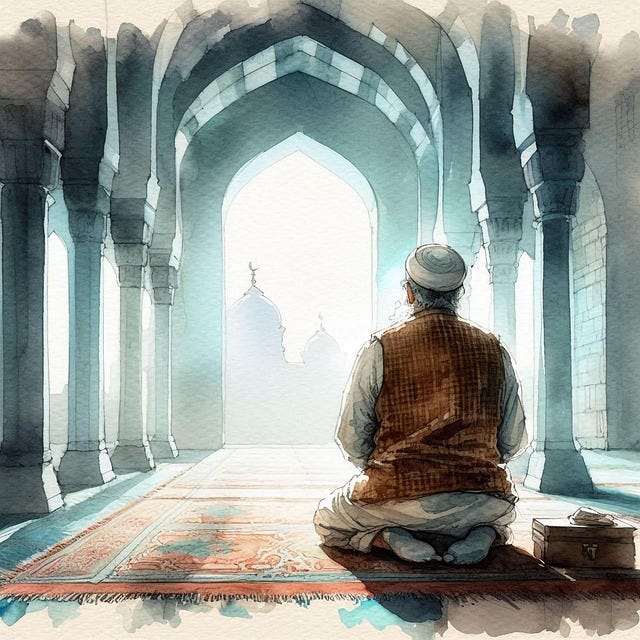The Hidden Cut: S2E5 -Submission and Identity
Circumcision in Islam: Tradition Without Command
Across the Muslim world, it’s a rite of passage. A celebration. A symbol. A sacrifice.
But it’s not in the Qur’an. So where did it come from? And why does it still matter so much?
Listen to the audio podcast episode.
The Unwritten Ritual
Welcome back to The Hidden Cut. This is Season 2: The Sacred Cut.
Today, we enter a space that blends reverence with ritual, and obedience with identity. Because in Islam, circumcision isn’t written law. But it might as well be.
The Practice of Khitan
Circumcision—called khitan—is practiced by nearly all Muslim men. In some regions, it happens in infancy. In others, at age 7. Or 13. Sometimes with great ceremony. Sometimes quietly at home. It’s seen as purification. As proof of belonging. As a necessary act of faith. Even though the Qur’an… doesn’t mention it.
It’s not law. But it’s lived. And for many, that’s just as binding.
Today, circumcision in Muslim-majority countries is nearly universal. In places like Egypt, Saudi Arabia, and Pakistan, rates hover between 95 and 100%. Indonesia—the world’s largest Muslim nation—follows suit, an almost total consensus across hundreds of millions of men.
By comparison: Israel reports rates above 90%, tethered to covenant. The United States? Around 70%, though dropping—rooted not in faith, but in medicine and war. South Korea, influenced by U.S. military presence after World War II, saw circumcision rates explode from near zero to over 90% in just two generations.
The pattern is telling: the highest circumcision rates cluster in three zones—Jewish covenant, Islamic tradition, and nations reshaped by American medical-military influence, itself fueled by Protestant purity panic and steered in part by an increasingly prominent Jewish medical establishment.
Everywhere else—the rest of Asia, South America, most of Europe—the body remains intact.
So how did a ritual born in the desert become a global empire of the flesh? And why do its strongest footholds exist where covenant, prophet, or empire demands obedience?
And somehow, it all seems to tie back to Abraham, and that pesky covenant that keeps showing up again, and again.
The Prophet’s Example
The Prophet Muhammad is reported to have been circumcised—either at birth, or during childhood. Sources differ.
But what matters is the Sunnah—his example. That’s where the tradition takes root. It becomes part of fitrah—natural human disposition. Alongside clipping nails, brushing teeth, and shaving underarms.
But khitan stands apart. It involves pain. Blood. A permanent mark.
The Unexplained Expectation
In many Islamic societies, to be Muslim is to be circumcised. Period. Mosques may refuse to perform weddings for the uncircumcised. Families may treat it as the true moment of entry into manhood.
On social media, debates over the “right age” for circumcision play out like Marvel fans arguing Spider-Man canon timelines. But here’s the deeper question: Why? If it’s not in the Book, why is it in the body?
And when you zoom out, the pattern looks hauntingly familiar. Every circumcision culture, across history, seems to enforce the blade with the same weapons: shame and ridicule.
Among Muslims, an uncircumcised man risks being treated as incomplete, unclean, or even a social outcast.
In Judaism, the arel—the uncircumcised—was seen as cut off from the covenant, sometimes derided as spiritually defective.
In America, circumcision was normalized through sitcom punchlines, locker-room teasing, and porn tropes until silence itself became complicity.
The pattern stretches even further back. In ancient Egypt, reliefs depict circumcision as the mark of civilization—and foreigners mocked as “uncut barbarians.”
In medieval Europe, Christian polemics ridiculed Jews for their obsession with circumcision. And that’s the irony: ridicule was once so loud it echoed in sermons and satire, while today the practice is so untouchable that even raising the question feels taboo. Imagining having permission to laugh at it now almost feels surreal.
The tools may change—family pressure, loss of honor, comic humiliation—but the logic doesn’t. Comedy and shame guard the ritual. The threat of laughter becomes as sharp as the knife.
The Abrahamic Inheritance
Islam honors Abraham—Ibrahim—as the father of monotheism. As the model of obedience. As the one who passed every test. Including… the cut.
Even without covenant language, the body of the Muslim man bears Abraham’s mark. It begs the question: Why did Islam adopt the mark of Abraham… without the contract?
Was it spiritual inheritance—or cultural submission?
The Operating System Theory
Here’s the emerging idea: Judaism made the covenant. Christianity tried to delete the file. But Islam installed the update.
Circumcision has become the Abrahamic operating system—invisible, global, persistent. Even if no one takes the time to read the license agreement.
The mark persists. The terms are forgotten. But the contract keeps renewing.
Dissent and Variation
Across the Muslim world, practices vary: age, method, ritual. In some cultures, circumcision is marked with feasts and music; in others, it’s a quiet act at home.
And in recent years, dissent is rising. Modern Muslims question pain, consent, and medical necessity. Some call for reform. Others call it betrayal.
This isn’t new. Even in earlier centuries, voices inside the Islamic world debated its necessity. Ottoman scholars disagreed on timing and medical impact. In the 19th century, reformers questioned whether khitan was essential to Islam at all. And today, some Muslim doctors quietly advise against unnecessary surgery—though rarely in public.
When the body is the proof of devotion, what happens when the body says no?
The Next Step Backward
Next time, we zoom out. Past Abraham. Past the covenant. To the tribal rites. To the gods of sacrifice. To the bodies that bled long before a single verse was even written.
Because if Abraham didn’t invent the blade, who did?
Until then, you’re listening to The Hidden Cut. This is The Sacred Cut.
And the code we run on… may be older than Scripture.
Further Reading & Receipts
Khitan (Circumcision in Islam) — Wikipedia
A comprehensive overview of khitan, noting that while circumcision is nearly universal in Muslim societies, the Qur’an never mentions it directly. Its authority comes from hadith and the Sunnah. https://en.wikipedia.org/wiki/Khitan_%28circumcision%29Bodily Integrity and Male Circumcision: An Islamic Perspective — G. Alahmad et al., NCBI/PMC (2012)
Explores how circumcision fits into Islamic views of bodily integrity, highlighting the tension between religious custom and personal autonomy. https://pmc.ncbi.nlm.nih.gov/articles/PMC3516177/Is Circumcision “Necessary” in Islam? A Philosophical Argument Based on Peer Disagreement — H. Dabbagh (2022)
Examines scholarly disagreement over whether circumcision is obligatory or merely recommended, and how different schools of thought approach the practice. https://link.springer.com/article/10.1007/s10943-022-01635-0Circumcision — Encyclopaedia Iranica
Traces the history of circumcision in Persian and Islamic contexts, noting its absence in pre-Islamic Iranian religion but later adoption as Islamic consensus solidified. https://www.iranicaonline.org/articles/circumcision/Evidence & Ethics on: Circumcision — Evidence Based Birth
Reviews the medical evidence and ethical debates surrounding circumcision, useful for understanding how religious tradition intersects with health and consent. https://evidencebasedbirth.com/evidence-and-ethics-on-circumcision/
🎬 Continue the Series
← Previous Episode: Of Prophets and Foreskins
→ Next Episode: Circumcision in Global Religion & Culture
📂 Full Episode Guide: Cold Open
Think something got left on the cutting room floor?
Add your notes below—we’re still editing in real time.






